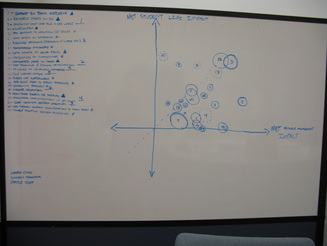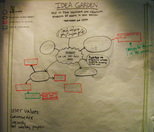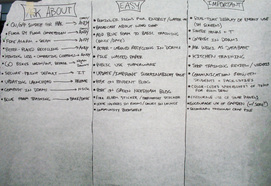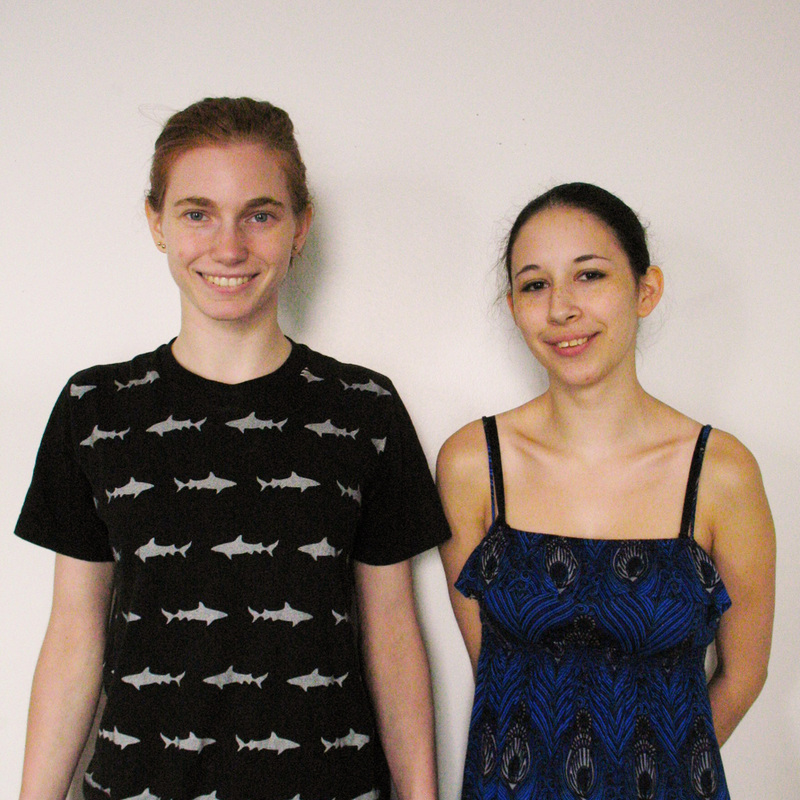 Our work days on Thursday and Friday consisted largely of creating graphs and charts to help us prioritize our remaining ideas and to understand the problems we've identified. We also have some pretty graphs of the data-organization kind. We hope to continue to gather this data and present it to the public at Olin.
Prioritizing
First, we wrote a big list of all of our remaining ideas. We then identified three important parameters that would help us prioritize these ideas: impact on resource management, impact on student life, and effort. We used these three parameters to plot each idea on a graph, with resource management on the x axis, student life impact on the y axis, and difficulty for us indicated by the size of the circle. Obviously all of these metrics are hugely approximate and subject to our opinions, but with so many diverse ideas we had to find some mildly quantifiable way to compare them. Ideally, we would pursue small circles that were high in the top right corner; unfortunately, this was not as simple as it sounds. Some ideas did not have much impact but required so little effort that we felt it was silly not to pursue them. Other ideas were already partially in progress, and still others we had already promised third parties to pursue. Thus, our prioritization had to be altered a bit. The list to the left shows stars next to the easy ideas, triangles are next to the ideas that are in progress or were promised, and rankings by the ones that fit neither category.
Data
As discussed in the previous post, we have taken on the project of supplying daily energy use data for the dorms to make people more conscientious of how they use energy. We set up a shared spreadsheet with the Plant Manager, Corey Cavicchi, who will see that it is updated with the energy use of each dorm every day (except weekends, which will have to be averaged). There is a graph on the spreadsheet that is updated automatically, which we plan to have displayed on the flat-screens in the dining hall/Milas Hall for everyone to see. We may also add it to the Sustainability Efforts page on the Olin website (or maybe somewhere that gets more student traffic; suggestions are welcome). And again, if all of that goes well, we'd like to try having an energy-saving competition between the dorms.
Thanks for reading; we'll keep updating you on these projects! And, as always, if you have any feedback or questions, email us, find us, or fill out our "Contact Us" form (the link can be found at the top of the page).
Throughout the past few weeks we've been come up with and been given tons of great ideas. Most of these ideas require the participation of one or more outside groups to help us implement them, so the better part of this week has been spent running back and forth between meetings. Here are a few of the highlights from those:
Plant Operations
Our first meeting of the week was with Corey Cavicchi, the Associate Plant Manager. We discussed the HVAC system at Olin, as well as possibilities for tracking and reducing energy usage. Most of the HVAC-related stuff was covered in the last post, but in case you didn't read that one, here's a quick recap: Facilities plans to install on/off switches for the dorm thermostats this summer, and we plan to put "Things You Should Know" signs on the thermostats so that everyone knows what's up.
A second idea we discussed with Corey was the possibility of a co-curricular involving Facilities where participants learn about the inner workings of the school, from the electrical and mechanical layouts to the software controlling them to the grounds and dining operations. Both Corey and Andy support this idea, and if you have any suggestions or things you think would be cool to learn, let us know.
Awareness is a huge factor in creating sustainable energy use habits. If you know how much of a resource you're using, whether it's money, energy, or gasoline, you're generally inclined to use less. We discussed creating a shared spreadsheet that Facilities could update each day with energy data so that we could generate graphs and statistics of the college's energy use habits. These graphs and statistics would be made publicly available, hopefully on the screen in the dining hall, to encourage more conscientious energy use throughout the school. If this idea succeeds, we want to set up a competition between East Hall and West Hall with some kind of prize for the dorm that uses the least energy. We originally wanted to organize a floor-by-floor competition, but, unfortunately, there are not currently sub-meters at the floor level. We're looking into the possibility of acquiring more sub-meters for the dorms, but that may not happen this summer.
Dining Hall
The second meeting was with Dave Nadreau, the General Manager of Olin's dining hall. We had arranged the meeting to discuss several problem points that we and our interviewees had identified, including the lack of complete accommodation for those with dietary restrictions, the large amount of waste produced, and the significant number of disposable cups and take-out boxes used daily. But, in talking with Dave, we learned that he and his staff are already far ahead of us on these issues.
To address dietary restrictions, a staff member will be designated to spend extra time with the weekly menu to ensure that there are options to meet everyone's needs each day. As for the waste problem, a new system will be set up where students will separate their waste into different bins for food, paper, recyclables, and trash. This will make it possible for the dining hall to dispose of the different types of waste in appropriate ways and keep compostable or recyclable items from needlessly taking up space in landfills.
Dave also hopes to have a system in place by the fall to "reclaim" disposable cups. The plan involves purchasing specialized bins that have three compartments: one for the recyclable lids, one for the compostable cups, and a third for the remaining contents of the cup. In addition to reclaiming these used Aspretto cups, the dining hall had also planned to partially replace the disposable cups and takeout boxes with reusable mugs and containers through Sodexo's "Choose to Reuse" program. Unfortunately, the Needham Health Board would not allow the program in the manner it was proposed; we will work with the dining hall and fellow students to create a revised proposal.
Machine Shops
Yet another meeting this week was arranged with Bruce Andruskiewicz, the Instructor of Machining. We discussed several ideas, some suggested by the Academic Facilities Committee and others by students, aimed at increasing the level of stewardship in the shops. We all agree that no students intentionally make messes in the shops, but they do often lack the proper training or forget to clean up or return tools when they are finished. Ideas to help alleviate these problems include creating a database of video tutorials explaining the machines, placing laminated cards on or near machines to remind students how to use them properly, implementing some sort of required training review, moving the date of basic training to sometime after orientation, and adding blue foam cutting to basic training. It became clear that ideas involving basic training would be better discussed with Design Nature professors, but Bruce was supportive of all the suggestions. We will probably not get through all of them this summer, but we'd really appreciate your input on which you think are most important (or any different or better ideas regarding the shops).
In short, we have made some promising progress this week and are excited to say that our ideas have been met with optimism and support. We can't wait to spend the next week working toward more positive changes. And as always, if you want to ask, suggest, correct, or discuss anything, please don't hesitate to contact us!
Week two is behind us now, and it still feels like we haven't actually done all that much. But when I look back at everything that happened last week, I realize that we are definitely making progress, even if much of it isn't publicly visible yet. Right now we're trying to make a lot of little changes that will hopefully add up to large improvements in Olin's resource use. Based on what our interviewees have been telling us, much of the misuse/disuse/wasting of resources results from poor communication between Facilities and the student body. We are hoping that providing knowledge about what goes on behind the scenes will make students more aware of Olin's resources and how their behaviors impact those resources. For those of you wondering what exactly I mean by all that hand waving, here are a few of the things we've been working on:
Thermostat Information Stickers
A lot of people get frustrated with the thermostats here, thinking they just don't work or have an awful interface (the latter being pretty true). And while our thermostats do actually work, they don't operate in the way most people would assume. The actual temperatures at which the HVAC system can be activated are limited depending on the season as an energy-saving measure. When the heating is on, temperatures range from 55-72. If your room's temperature is above 72, the heat will not turn on, regardless of your thermostat set point. When the cooling is on, temperatures range from 72-85, such that the cooling will not turn on if your room is below 72, regardless of your actual thermostat set point. Many people have noted that it would be helpful to add a button to toggle the heating/cooling on and off in individual rooms. This would save energy when people are absent or certain rooms are not being used. Facilities plans to make this change during the summer--our rooms (405 and 106b) will actually be the testing grounds for the system. Since not everyone will read this blog post, we also decided to create "Things You Should Know About Your Thermostat" stickers for each dorm room so that people will be appropriately informed about their thermostats and can tell (and report) when something is actually broken.
Composting
Did you know that there used to be a compost bin in the West Hall kitchen? Neither did we, because it looked exactly like a trash can and wasn't labeled in a noticeable manner. Once trash or any kind of processed food is put in a compost bin, the compost is ruined, which means that unlabeled bins are doomed to failure. After a week or so of throwing away perfectly compost-able food scraps in East Hall this summer, we decided it would be a good idea to revive composting in the dorm kitchens in a more conscientious way. Thus far we've purchased some clear, distinctly non-trash-looking bins and have created accompanying signs detailing what can and cannot be composted. Hopefully this will lead to successful composting endeavors. We will need a couple of volunteers to help us take out the compost when necessary; if you're interested in this small opportunity to help make the college better, shoot us an email!
Steps Toward Improving the Kitchen
The kitchen is the source of numerous complaints from our interviewees, which does not surprise us in the least. There are always dishes accumulating in the drying rack, gross water on the floor and the counters, few clearly marked places to put things away, half-eaten meals/unwashed dishes lying around, and a general lack of respect for shared equipment. In an effort to alleviate at least some of this mess, we've purchased a large supply of dish towels and will soon install a towel rack; hopefully this will give people the activation energy they need to actually dry and put away their dishes. We're also piloting a system to ensure that the towels get washed on a weekly basis: whoever plans to do laundry at the end of that week can sign up to wash the dish towels as well. That way there will always be a clean set of towels, and--as long as it's not the same few people washing them every time--an increased sense of ownership among kitchen users.
In short, things are coming along. We've got a multitude of projects going on, some of which you can look at in detail if you mouse over the "Projects" tab at the top, and we're making headway on all of them. Thanks for reading and stay tuned for some bigger changes!
 All ideas, grouped and color-coded. So we've completed our first week on the job and we're pretty happy with our progress! The first (tangible) thing we did was send a survey to all Olin students asking about their habits, as well as requesting ideas on how to improve our school. The purpose of this survey was to help us understand the status quo at the beginning of our internship; it's difficult to make incredible changes without knowing where Olin already stands. The survey received responses from about a third of the entire student body, all of which were helpful.
Since sending out our survey, we have also conducted several in-person interviews to ask other students what changes they want to see and what problems need to be addressed. We also discussed the merit and feasibility of several ideas we generated on our own. These interviews have helped tremendously in narrowing down our very large list of ideas and in refining each of the remaining ideas.
 Our first Idea Garden. We are now experimenting with another method of obtaining the student perspective on different Facilities-related issues. We have created an "Idea Garden" near the dorm kitchen, which presents one major issue we have identified, as well as several possible solutions. The Garden basically functions as an open flow chart for the community to point out problems with our ideas and suggest their own solutions. We are planning to do several of these Idea Gardens, but the currently posted one focuses on ways to decrease Olin's absurdly high paper usage.
 A refined list of ideas, categorized by difficulty. At this point, we have a (still quite large) list of specific changes we want to implement. We have contacted dozens of people to learn more about the problems we hope to address. The first Idea Garden is in progress and new Gardens are to come. This week, we plan on completing some of our smaller or easier projects and ideas while we wait on more information pertaining to our larger ideas.
We plan to add more pages to this site for more of our projects when we get the chance and we will be updating this blog with our progress quite frequently, so stay tuned!
~Anne-Marie and Steph
|





 RSS Feed
RSS Feed